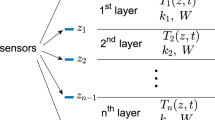Abstract
Heat transfer was studied between intact leaves of various sizes and shapes in vivo under free and forced air conditions. Use of a wind tunnel and a microwave transmitter to heat the leaves facilitated measurements of convective, along with radiative and evaporative, heat losses from plant leaves. Knowledge of input energy, analysis of cooling curves, and established formulae, respectively, formed the basis of the steady-state, unsteady-state, and analytical methods for the determination of heat transfer coefficients.
Typical values of steady-state free convection coefficients for Peperomia obtusifolia varied from 1.5 × 10−4 to 1.9 × 10−4 cal cm−2 s−1 C−1 as the temperature difference was increased from 5.9 to 9.6°C, whereas the forced convection coefficient was found to be 4.2 × 10−4 cal cm−2 s−1 C−1 at 122 cm s−1 wind velocity. For egg-plant, this value was about 9 × 10−4 cal cm−2 s−1 C−1 at 488 cm s−1 wind velocity. Convection coefficients as determined under steady-state conditions are compared with those of the unsteady-state and with analytical values for a single leaf and leaves of three different plants. In general, experimental values were found to be higher than the analytical ones.
Similar content being viewed by others
References
Fuchs, M. and Tanner, C. B.: 1966, ‘Infrared Thermometry of Vegetation’, Agron. J. 58, 597–601.
Gates, D. M.: 1961, ‘Winter Thermal Radiation Studies in Yellowstone Park’, Sci. 134, 32–35.
Gates, D. M.: 1962, Energy Exchange in the Biosphere, Harper-Row, New York.
Gates, D. M.: 1963, ‘The Energy Environment in Which We Live’, Amer. Sci. 51, 327–348.
Gates, D. M.: 1965, ‘Energy, Plants and Ecology’, Ecology 46, 1–13.
Gates, D. M.: 1967, ‘Thermal Balance of the Biosphere’, Int. J. Biometeorol. 3, 29–39.
Gates, D. M.: 1968, ‘Energy Exchange Between Organisms and Environment’, Aust. J. Sci. 31, 67–74.
Gates, D. M.: 1969, ‘The Ecology of an Elfin Forest in Puerto Rico, 4. Transpiration Rates and Temperatures of Leaves in Cool Humid Environment’, J. Arnold Arb. 50, 93–98.
Idle, B. D.: 1970, ‘The Calculation of Transpiration Rate and Diffusion Resistance of a Single Leaf from Micrometeorological Information, Subject to Errors of Measurement’, Ann. Bot. (London) 34, 159–176.
Kanemasu, E. T., Thurtell, G. W., and Tanner, C. B.: 1969, ‘Design, Calibration and Field Use of a Stomatal Diffusion Porometer’, Plant Physiol. 44, 881–885.
Kreith, F.: 1965, Principles of Heat Transfer, Intern. Textbook Co., Pa.
Linacre, E. T.: 1964, ‘Determinations of Heat Transfer Coefficient of a Leaf’, Plant Physiol. 39, 687–690.
Parkhurst, D. F., Duncan, P. R., Gates, D. M., and Kreith, F.: 1968, ‘Wind Tunnel Modelling of Convection of Heat Between Air and Broad Leaves of Plants’, Agr. Meteorol. 5, 33–47.
Raschke, K.: 1960, ‘Heat Transfer Between the Plant and the Environment’, Ann. Rev. Plant Physiol. 11, 111–126.
Thom, S. A.: 1968, ‘The Exchange of Momentum, Mass and Heat Between an Artificial Leaf and the Air Flow in a Wind Tunnel’, Quart. J. Roy. Meteorol. Soc. 94, 44–55.
Author information
Authors and Affiliations
Rights and permissions
About this article
Cite this article
Kumar, A., Barthakur, N. Convective heat transfer measurements of plants in a wind tunnel. Boundary-Layer Meteorol 2, 218–227 (1971). https://doi.org/10.1007/BF00192131
Received:
Issue Date:
DOI: https://doi.org/10.1007/BF00192131




